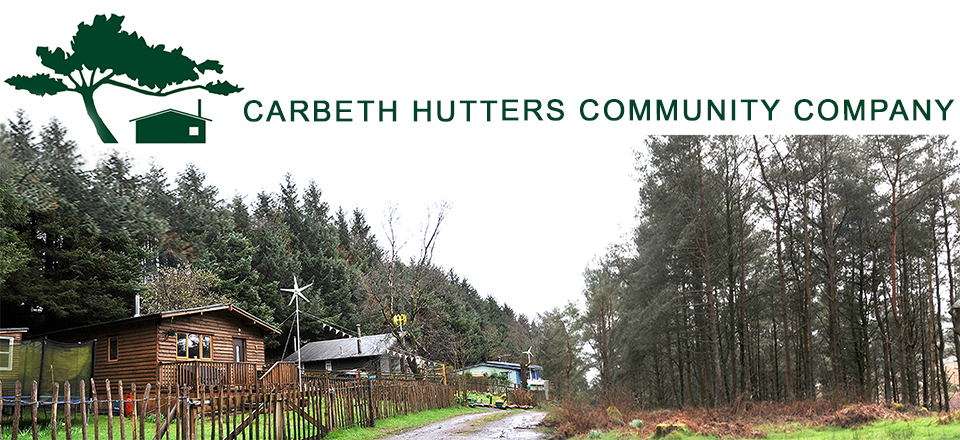The Craigallian Fire
The conquest of fire was a fulcrum moment in the evolution of humanity. Amongst the many functions it provided was a source of comfort and companionship, key in the development of social evolution. Fire was a focal point in human communities around which language developed and ideas were formed.
Between 1920 till the late 1930s a campfire burned by the side of Craigallian Loch. According to legend it was kept alight until it was extinguished at the onset of WW11 in 1939, lest it served to guide enemy bombers.
Sharing the same location, the fire came into existence around the same time as the Carbeth Hutting Community and the prolific Carbeth camping sites. They are all inextricably linked, born out of the same purpose, driven by the same desires.
This Craigallian fire however is unique. It created by the circumstances of the time a focal point for the meeting of diverse minds. Unemployment in the 20s and the depression of the 30s were its catalysts. Around the fire a dynamic community formed. Released from the divisions of social class the fire brought together an extraordinary mixture of unemployed, idealists, intellectuals, academics and political activists.
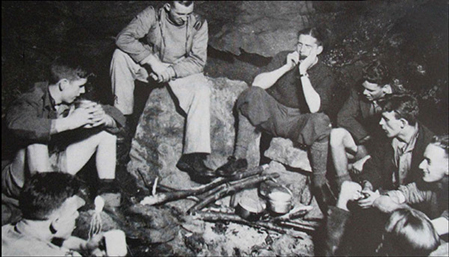 |
Craigallian Fire Sitters |
Their common bond was a love of the open air and the enduring historical Scots struggle by Scottish people for freedom to access land and mountains that they loved.
Some Fire Sitters became pioneers in the movement to open up Scotland’s wild places to all people, others went to fight in the Spanish Civil War against the rise of fascism in Europe.
They gathered, debated, educated and of course entertained. Many Hutters were also Fire Sitters and many Fire Sitters became Hutters. Many young men and women, yet to be distinguished in the world of politics, education and climbing, were to find their inspiration and direction in the light of its flames. Broadcaster Tom Weir, Jock Nimlin, pioneering climber, Political activist David McConnell, Professor Sir Robert Grieve and Professor Ian McHarg were Fire Sitters. By its flickering light were born famous mountaineering clubs like the Creagh Dhu, Lomond and Ptarmigan.
For Hutters the fires existence did not end in 1939, extinguished as it was in its pre-war quenching. The haunting premonition of the bomber became a reality. Two years later, Clydebank was brutally Blitzed resulting in the death of 528 citizens, the grievous wounding of 617 others and the catastrophic loss of homes and community. Only 7 houses remained intact out of a stock of 12,000.
 |
Clydebank Burns 13 March 1941 |
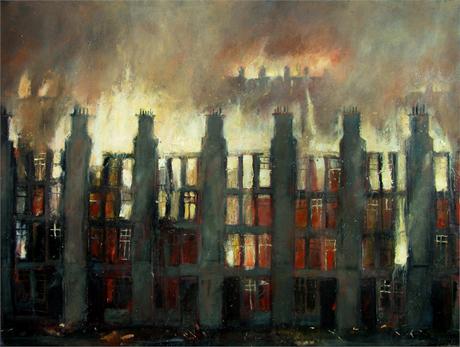 |
'Burning Terraces' a Blitz painting by Tom Mckendrick |
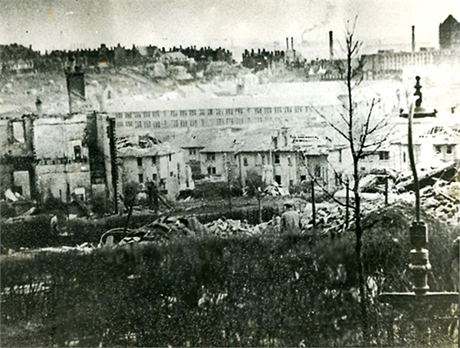 |
Clydebank April 1941 |
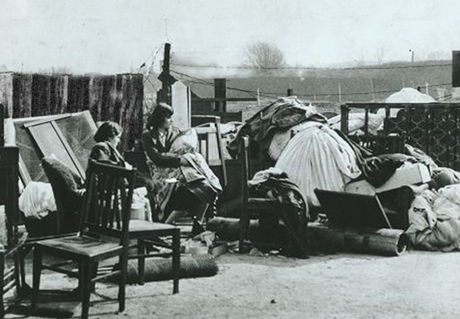 |
A Blitzed family arrive at Carbeth |
Carbeth became home to the homeless and a shelter for the traumatized. Life went on. Workers trekked back and forth from Carbeth to Clydebank, some daily, across a now famous route aptly named the 'Bankie Trek,' The site of the Craigallian Fire became the journey rally point. The fire temporarily lit served as a 'brew up' site and always extinguished as darkness fell.
At the wars end fires were lit throughout the land in celebration of victory. Where better than Craigallian for the Hutters to celebrate the new hard fought peace. It is told that the evening started well. Songs were sung, spirits were high and the celebration attracted many. As the festivities got underway a barrel of beer was rolled in amid a great cheer, allegedly 'borrowed' from the Carbeth Inn.
Late in the evening a young woman rose to her feet to sing "Rowan Tree" a song written by a woman, for women, It is a gentle song reflecting on motherhood, family life and passing time. Sensing the moment the throng hushed. By the songs end all were overwhelmed. The grim reality of their collective history bit deep and hard.
Fire etiquette dictated that you did not arrive empty handed, and the fuel that you burned was replaced for the next visitor. In the still that followed a young Hutter named Kenneth Daniels rose to his feet, lifted a piece of kindling from the stock pile and placed it on the fire... then left, quietly disolving into the darkness.
It would perhaps be to much to assume that this gesture was intended to be symbolic...but what followed was unique to the moment. In an order dictated by respect and loss...Hutters rose, some singly others in family groups ...lifted a piece of kindling...fed it to the flames lingered for a moment then left. What remained at the rituals end was a fire alone, left to die.
The children of that war generation were taught well this history ensuring the significance of the fire as a special place lived on
A ritual, which still exists to this day, and right of passage for young Hutters is to 'trek' the path. Some even attest this to be their earliest childhood memory..
Nearing the journeys end at Craigallian they were made aware of 'fire etiquette' and lifted fuel ...an adult would inform the walkers "I will scout on ahead to make sure all is ok with the fire" The children arrived amid the crackle of burning and rising blue smoke, tea brewing, and believing without question these very flames had been alive for 40 years. Every Carbeth adult was of course in on the ruse but it served well the memory of the place.
In reflection of the fires importance Iain Grieve, Willie Grieve and David Campbell. instigated a project to commemorate the fires existence. They are to be applauded for preserving such an important part of peoples history. ' The Friends of the Craigallian Fire’ raised the money and commissioned a memorial sculpture by artist Tim Chalk, which echoes the 'ring' and 'standing stone' art of the ancient Celts. The official opening of the memorial took place on15 September 2012.
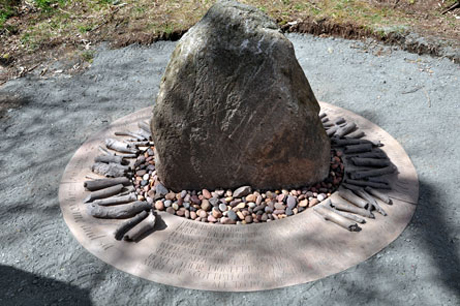 |
Craigallian Memorial |
The work has an inscription which reads
"Here burned the Craigallian Fire. During the depression of the 1930s, it was a beacon of companionship and hope for young unemployed people who came from Glasgow and Clydebank seeking adventure in Scotland’s wild places. Their pioneering spirit helped to make the Scottish countryside free for all to roam."
![]()
Links
Read about the Craigallian Fire, Fire Sitters stories, the sculpture and more.
Read more about the Bankie Trek with photographs, and rights of way in Scotland.
Read more about the Clydebank Blitz,. stories, images and history.
The words to the song Rowan Tree.
Marlene, an evacuees Story .
